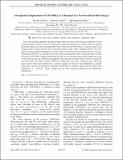Astrophysical Implications of GW190412 as a Remnant of a Previous Black-Hole Merger
Author(s)
Gerosa, Davide; Vitale, Salvatore; Berti, Emanuele
DownloadPublished version (1.202Mb)
Publisher Policy
Publisher Policy
Article is made available in accordance with the publisher's policy and may be subject to US copyright law. Please refer to the publisher's site for terms of use.
Terms of use
Metadata
Show full item recordAbstract
© 2020 American Physical Society. Two of the dominant channels to produce merging stellar-mass black-hole binaries are believed to be the isolated evolution of binary stars in the field and dynamical formation in star clusters. The first reported black-hole binary event from the third LIGO/Virgo observing run (GW190412) is unusual in that it has unequal masses, nonzero effective spin, and nonzero primary spin at 90% confidence interval. We show that this event should be exceedingly rare in the context of both the field and cluster formation scenarios. Interpreting GW190412 as a remnant of a previous black-hole merger provides a promising route to explain its features. If GW190412 indeed formed hierarchically, we show that the region of the parameter space that is best motivated from an astrophysical standpoint (low natal spins and light clusters) cannot accommodate the observation. We analyze public GW190412 LIGO/Virgo data with a Bayesian prior where the more massive black hole resulted from a previous merger and find that this interpretation is equally supported by the data. If the heavier component of GW190412 is indeed a merger remnant, then its spin magnitude is χ1=0.56-0.21+0.19, which is higher than the value previously reported by the LIGO/Virgo collaboration.
Date issued
2020Department
LIGO (Observatory : Massachusetts Institute of Technology); MIT Kavli Institute for Astrophysics and Space Research; Massachusetts Institute of Technology. Department of PhysicsJournal
Physical Review Letters
Publisher
American Physical Society (APS)